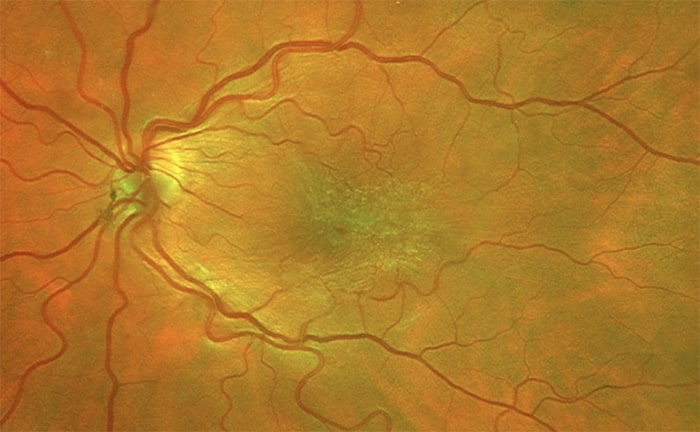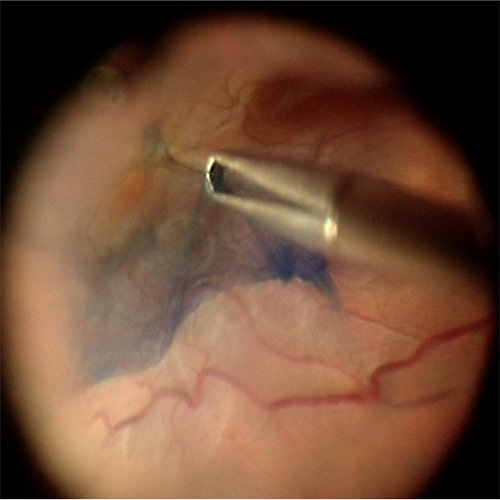Epiretinal membrane (ERM)
Epiretinal membrane (ERM) is also known as macular pucker, cellophane maculopathy, preretinal fibrosis, or surface wrinkling retinopathy. These names all refer to the growth of scar tissue over the macula, the center portion of the retina which provides central vision. As the membrane wrinkles, it distorts the retina, thereby distorting the vision.
Causes & Symptoms

This demonstrates an epiretinal membrane in the macula. Notice the appearance of wrinkled cellophane.
Symptoms include blurred or distorted vision, both for distance and reading. The cause is typically due to aging of the vitreous gel, which over time shrinks and liquifies, causing cells to settle on the macula and grow into a sheet of scar tissue. ERM can also be seen with retinal tears and detachment, eye trauma, uveitis or other inflammatory diseases, diabetic eye disease, and other blood vessel disorders of the retina.
Epiretinal Membrane Fact Sheet
Download one of the following documents to learn more about epiretinal membrane (ERM).
Treatment
In most cases, ERMs are mild with little effect on vision, in which case they are left alone and monitored. In moderate to severe cases, the central vision may become distorted or blurred enough to cause difficulty with reading, driving, and other daily life activities. Left untreated, ERMs do not lead to blindness, instead only impairing central vision.
Surgery

Epiretinal membranes are often stained blue to make them more visible during surgical removal (peeling). This illustrates a membrane being peeled from the macula.
If the visual symptoms are significant and are affecting a patient’s function and/or quality of life, surgery can be done remove the ERM. This operation is called a vitrectomy, performed on an outpatient basis and takes about 30-45 minutes. Under either local or general anesthesia, small instruments are inserted into the eye to remove the vitreous gel, followed by peeling the membrane off the surface of the retina. Sutures are generally not needed, allowing faster healing after surgery.
Post Surgery
After surgery, eye drops are used for one to two weeks, with reading, television, computer use, and light activity permitted immediately after surgery. The eye is usually healed within two weeks with a refraction for new eyeglasses suggested several months after surgery.
Vision improves slowly after this type of surgery, with most of the improvement in the first three months, with some further improvement possible up to 2 years after surgery. Vision usually does not return to normal and some distortion may persist, but for most people, their overall vision and distortion improve.
Surgical Risks
Risks of surgery include bleeding, infection, and retinal detachment. While these risks are small, they can rarely lead to blindness in the operated eye. Cataract progression is normal and expected after this type of surgery except if one has already undergone cataract surgery, since cataracts do not regrow.
Conclusion
In summary, epiretinal membranes are common and for most people, do not require treatment. In significant cases they can be removed surgically with high likelihood of vision improvement.
Need more information?
Schedule an Epiretinal Membrane Consultation with Colorado Retina Associates
As the premier retina practice of the Rocky Mountains, Colorado Retina Associates provides advanced diagnostic care and treatment for Epiretinal Membrane. Schedule a consultation today with one of our retina specialists in the Denver, Boulder, Aurora, and Lakewood areas.

